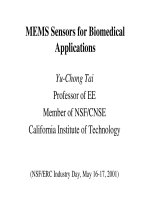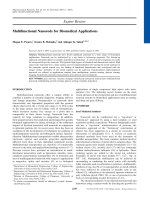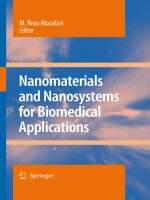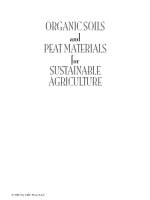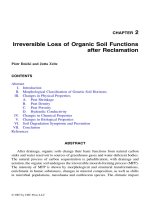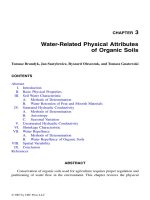Self assembly peptide amphiphile biomimetic materials for biomedical applications
Bạn đang xem bản rút gọn của tài liệu. Xem và tải ngay bản đầy đủ của tài liệu tại đây (3.76 MB, 171 trang )
SELF-ASSEMBLING PEPTIDE-AMPHIPHILE
BIOMIMETIC MATERIALS
FOR BIOMEDICAL APPLICATIONS
LUO JINGNAN
NATIONAL UNIVERSITY OF SINGAPORE
2012
SELF-ASSEMBLING PEPTIDE-AMPHIPHILE
BIOMIMETIC MATERIALS
FOR BIOMEDICAL APPLICATIONS
LUO JINGNAN
(M. Eng., B. Eng., Tian Jin University)
A THESIS SUBMITTED
FOR THE DEGREE OF DOCTOR OF PHILOSOPHY
DEPARTMENT OF CHEMICAL AND BIOMOLECULAR
ENGINEERING
NATIONAL UNIVERSITY OF SINGAPORE
2012
To my dearest parents and sisters
To my beloved, Zhang Ying
i
ACKNOWLEDGEMENTS
First and foremost, I would like to express my deepest and most sincere gratitude to my
thesis advisor, Professor Tong Yen Wah, for giving me not only the opportunities to learn
and grow but also freedom to try and err. I am sincerely grateful to his invaluable
patience and advice not only in scientific but also in personal matters, such as career
planning and job seeking. Thank you for your patience and guidance.
I would like to thank Professor Jiang Jianwen and Professor Yang Kun-Lin for their
generous time and guidance during my Ph.D. qualifying examination. I also would like
to thank all past and present members of the Tong’s group, but particularly: Khew Shih
Tak, Wiradharma Nikken, Koh Shirlaine, Chen Wen Hui, Niranjani Sankarakumar, Liang
Youyun, Chen Yiren, Anjaneyulu Kodali, Wang Honglei, Xie Wenyuan, Ajitha
Sundaresan, He Fang, Guo Zhi, Wang Bingfang, Sushumitha Sundar, and Lee Jonathan,
for unconditional help and invaluable support. I also am grateful to other group members,
especially Tan Weiling, Duong Hoang Hanh Phuoc, Deny Hartono, Harleen Kaur, Fong
Kah Ee, and Meng Qiao, for providing a pleasant working environment. Additionally, I
would like to thank the Department of Chemical and Biomoleclar Engineering, National
University of Singapore for providing me the research scholarship and research facilities
that make this study possible.
Finally, I would like to thank my parents and sisters for their supports on my study. Their
unconditional love, support and guidance has made me who I am today. Lastly, I would
like to thank my best companion, Zhang Ying, for her care, love and selfless support.
ii
TABLE OF CONTENTS
ACKNOWLEDGEMENTS i
TABLE OF CONTENTS ii
ABSTRACT viii
LIST OF TABLES xi
LIST OF FIGURES xii
CHAPTER 1 1
INTRODUCTION 1
1.1 Background 1
1.2 Hypothesis 3
1.3 Research objectives 4
CHAPTER 2 6
LITERATURE REVIEW 6
2.1 Regenerative medicine and biomaterials 6
Biomaterials 10
2.2 The mimicking template: the extracellular matrices (ECM) 13
Integrins 14
The extracellular binding to integrins 15
The need of ECM mimics 16
Collagen 18
Collagen mimics 21
ECM adhesive proteins and their mimics 25
iii
2.3 The mimicking means: molecular self-assembly 26
Self-assembling peptide systems 26
Peptide amphiphiles 28
Approaches to program PA self-assembly 31
Functionalization of self-assembled PA nanostructures 33
CHAPTER 3 35
MATERIALS AND METHODS 35
3.1 Materials 35
3.2 Experimental section of chapter 4 35
Peptide synthesis 35
Critical micelle concentration (CMC) 36
Self-assembly of CPAs into nanofibers 37
Transmission electron microscopy 37
Circular Dichroism Spectroscopy 38
Melting studies 38
Cell culture 39
Cell adhesion assay 39
Immunofluorescence staining 40
Statistical analysis 41
3.3 Experimental section of chapter 5 41
Microsphere Preparation 41
Porous polymeric scaffolds 41
Peptide synthesis 42
Transmission electron microscopy 42
iv
Network structure of peptide hydrogel 43
Visualization of cell–nanofiber interaction 44
Cell culture 44
Cell adhesion assay 44
Cell spreading assay 45
Hybrid gel/scaffold system 46
Hybrid cell/gel/scaffold system 46
Cell proliferation 47
Albumin secr 48
Statistical analysis 48
3.4 Experimental section of chapter 6 48
Peptide synthesis 48
Fiber formation and gelation of PAs 49
Transmission electron microscopy 49
Scanning Electron Microscopy 50
Stop-flow analysis 50
3.4 Experimental section of chapter 7 51
Peptide synthesis 51
Preparation of assembled PA nanostructures 51
Transmission Electron Microscopy 52
Circular Dichroism Spectroscopy 53
Dynamic Light Scattering 54
CHAPTER 4 55
v
SEFL-ASSEMBLY OF COLLAGEN-MIMETIC PEPTIDE AMPHIPHILE INTO
BIOFUNCTIONAL NANOFIBER 55
4.1 Introduction 55
4.2 Results and Discussion 57
Design and synthesis of collagen-mimetic peptide amphiphiles 57
TEM study of morphological structure 60
CD spectra 63
Melting point study 64
Cell adhesion assay 69
Immunofluorescence staining 71
4.3 Conclusions 72
CHAPTER 5 74
THREE-DIMENSIONAL POROUS SCAFFOLD FILLED WITH ECM-MIMETIC
HYDROGEL TO OPTIMIZE LIVER CELL DISTRIBUTION, PROLIFERATION AND
FUNCTION 74
5.1 Introduction 74
5.2 Results and Discussion 77
Fabrication of ECM-mimetic fibrous hydrogel 77
Cell adhesion and spreading on ECM-mimetic nanofibers 83
Preparation of 3D porous PLGA scaffold 85
Hybrid gel/scaffold system 88
Cell growth and distribution unto scaffolds 89
Cell proliferation and function 92
5.3 Conclusions 94
CHAPTER 6 95
vi
HIERARCHICAL SELF-ASSEMBLY OF PEPTIDE AMPHIPHILES INTO FIBER
BUNDLES MEDIATED BY THE RGDS CELL-BINDING MOTIF 95
6.1 Introduction 95
6.2 Results and discussion 97
Design of peptide amphiphile 97
Characterization of self-assembled PA fibers 100
Proposed mechanism of hierarchical self-assembly 101
6.3 Conclusions 108
CHAPTER 7 110
POST-ASSEMBLY POLYMERIZATION OF PEPTIDE AMPHIPHILE NANOFIBERS
TO ENHANCE FIBER STABILITY AND CONTROL FIBER LENGTH 110
7.1 Introduction 110
7.2 Results and discussion 111
The strategy of post-assembly polymerization and scission 111
The design of PAs with unsaturated alkyl chain 112
The stability of PA nanofibers 117
The length control of PA nanofibers 119
7.3 Conclusions 120
CHAPTER 8 122
CONCLUSIONS AND RECOMMENDATIONS 122
REFERENCES 127
APPENDIX A 149
APPENDIX B 150
vii
viii
ABSTRACT
Biomaterial science has significantly evolved in the past half century and is one of the
major engines to boost the development of regenerative medicine. Both increasing
requirement for biomaterials and increasing appreciation of the functionality of biological
matrix caused scientists to consider nature for design and fabrication inspiration for new
generation of biomimetic materials. This thesis was designed to develop new class of
biomimetic materials that closely resembled the roles of natural materials and held great
potential for a number of biomedical applications, through using peptides as the building
blocks, the extracellular matrix (ECM) as the mimicking template, and peptide-
amphiphile self-assembly as the mimicking means.
The first part of the thesis was to fabricate collagen-mimetic peptide amphiphiles (CPAs)
to structurally and biologically resemble fibrous collagen that is the most abundant ECM
protein and plays vital roles in supporting cell growth and tissue function in vivo. The
CPA was prepared through incorporating the epitope of a collagen-mimetic peptide
(CMP) supplemented with a specific cell binding sequence GFOGER. It was showed that
the CPAs were able to self-assemble into nanofibers and remained triple-helical
conformation that was structurally unique to collagen. The results also demonstrated that
the self-assembled CPA nanofibers had cell binding ability for promoting liver cell
adhesion.
ix
Following that, a co-assembling strategy was applied to fabricate ECM-mimetic materials
based on the collagen-mimetic system. ECM-mimetic hybrid nanofibers carrying two
integrin-specific sequences of GFOGER and RGDS were prepared. It was showed that
the ECM-mimetic nanofibers were able to entangle to form fibrous hydrogel and improve
cell adhesion and spreading. The fabricated ECM-mimetic hydrogel was injected to a
three-dimensional porous polymer scaffold to form hybrid hydrogel/scaffold system. The
results demonstrated that the ECM-mimetic hybrid system displayed the ability to
optimize cell distribution, proliferation and function.
The third part was designed to present a hierarchical self-assembly pathway to form PA
fiber bundles by inducing and controlling inter-nanofibers interactions using RGDS. It
was proved that the hierarchical assembly and structure resulted from the complementary
electrostatic attraction between alternating charge patterns of RGDS. The findings that
RGDS type sequences functioned not only as bioactive motifs but also key structural
units in the lateral assembly of fibers could aid in better understanding of fibrillogenesis
in nature. The biomimetic hydrogel built up by fiber bundles had larger pore size and
better permeability for macromolecules, which allowed rapid diffusion of oxygen and
nutrients.
The control over the shape, size and stability of the self-assembled aggregate is desirable
but often technically challenging. Following the successful tailoring of fiber diameter, an
attempt was made to control the length and to enhance the stability of self-assembled
x
nanofibers. The fourth part of the thesis was aimed to present a strategy to control the
length and enhance the stability of self-assembled nanofibers via the post-assembly
polymerization and scission process. The results demonstrated the formation of self-
assembled nanofibers with the enhanced stability and the controllable lengths via
tweaking of the initiator concentration.
xi
LIST OF TABLES
Table 4.1 The primary molecular sequence of the collagen-mimetic peptide
amphiphiles (CPAs) and their molecular weights.
Table 5.1 The molecular sequences of synthesized peptide amphiphiles
Table 6.1 Side chain pK
a
value of charged amino acids
Table 7.1 Lengths (nm) of the polymerized nanofibers after scission as measured
from TEM images of at least 450 nanofibers.
Table A.1 Letter codes of naturally occurring and non-natural (marked with *) amino
acids.
xii
LIST OF FIGURES
Figure 2.1 Number of liver transplants and size of active waiting list for liver.
Figure 2.2 Number of kidney transplants and size of active waiting list for kidneys.
Figure 4.1 Molecular structure of CPA1 that contains four segments: lipophilic, β-
sheet, spacer and epitope segments. Bioactive GFOGER sequence is
inserted within repeating structural units (GPO) as the epitope segment.
The peptide portion is prepared via solid phase peptide synthesis and then
conjugated with palmityl acid.
Figure 4.2 CPA self-assembly process: three collagen-mimetic epitopes self-assemble
into a triple-helix, while the hydrophobic tails and β-sheet type hydrogen
bonding drive and guide the assembly of CPAs into nanofibers.
Figure 4.3 TEM micrographs of self-assembled PA nanofibers with the diameter of
~16 nm. PA concentration for testing was 0.1 mg/mL, which was diluted
from 1% w/v PA gel. (b) is enlarged image of (a).
Figure 4.4 CPA solution (a) with 1% w/v concentration was prepared in deionized
water and treated with NH
4
OH to screen the positive charges to form
hydrogel (b). The vial was tipped upside down to illustrate that the gels
was self-supporting. (c) SEM image of PA hydrogel after critical point
drying.
Figure 4.5 CD spectra of (a) CPA1, (b) CPA2 and (c) CPA3 obtained at room
temperature (blue color line) and 70
o
C (pink color line). Samples were
prepared at 0.5 mg/mL in water.
Figure 4.6 The unfolding melting studies of CPA1: (a) the unfolding melting curves
showed cooperative transition of CPA1 at different concentrations, 0.5
mg/mL (green line), 0.7 mg/mL (pink line) and 2 mg/mL (blue line); (b)
the first derivative of unfolding melting curves indicated the T
m
values of
39
o
C for 0.5 mg/mL, 39
o
C for 0.7 mg/mL, and 47
o
C for 2 mg/mL.
Figure 4.7 The melting curves of unfolding (blue line) and refolding (pink line) of
CPA1 (a) and CPA2 (c) prepared at 0.7 mg/mL show that the melting
transition of CPA1 and CPA2 is reversible. The rate of temperature
change is 0.25°C/min for the folding processes. The first derivative of
melting curves of CPA1 (b) and CPA2 (d) shows negative and positive
curves for the unfolding and refolding processes, respectively. The T
m
xiii
value of CPA1 is 39°C, lower than that of CPA2 with T
m
of 42°C. The
arrows represent the direction of temperature.
Figure 4.8 Adhesion of HepG2 cells as a function of surface compositions: heat-
denatured BSA (BSA), calf-skin collagen (collagen), CPA1, CPA2, CPA3,
CP1, CP2, and CP3. Cell adhesion to collagen was used as a 100%
reference level. Student t-test, with p<0.05 for * significantly different
from BSA, CPA2, CPA3, CP2 and CP3 and ^ significantly different from
CPA1 and CPA2.
Figure 4.9 Cell adhesion and spreading as a function of substrates: collagen (a),
CPA1 (b), CPA2 (c) and CPA3 (d). Cells were fixed and stained for actin
stress fibers (TRITC-phalloidin; red) and nuclei (DAPI; blue) after being
incubated in serum-free medium and examined by confocal microscopy.
Scale bar is 10 μm.
Figure 5.1 Schematic diagram to show co-assembly of PAs into hybrid nanofibers
(A); TEM images of hybrid nanofibers (B and C); SEM image of PA
hydrogel (D); and confocal image of stained PA fibers (E).
Figure 5.2 (A) SEM image of HepG2 cell on the surface of co-assembled nanofibers;
(B) HepG2 cell adhesion as a function of different components of BSA,
collagen, fibronectin, GFOGER-PA, RGDS-PA, collagen & fibronectin
combination, and RGDS & GFOGER-PAs.
Figure 5.3 Light microscope images (×10 times) of HepG2 cell spreading on BSA,
collagen and GFOGER &RGDS-PAs coated surfaces, at 1 hr and 2 hr (A);
percentage of HepG2 cells spreading on the surfaces coated with different
components at different time points.
Figure 5.4 SEM images of PLGA scaffold cross-section (A and B), microsphere (C),
and PLGA / PHBV scaffold cross-section (D); confocal image of PLGA
scaffold (E); and photo PLGA scaffold (F). The red arrows represent
insertd microspheres.
Figure 5.5 SEM (A and B) and CLSM (C and D) images of gel-filled scaffold cross-
section.
Figure 5.6 CLSM images of three layers of cells/scaffold construct (A-C) and three
layers of cells/ hydrogel/scaffold construct (D-F); schematic diagram to
illustrate the difference in cell growth mannerism in porous and gel-filled
scaffolds (G); CLSM image of cell aggregates in gel-filled scaffold (H);
and CLSM image to show cell infiltration in gel-filled scaffold (I). The
scale bar of images (A-F) is 100 µm.
xiv
Figure 5.7 (A) Proliferation of HepG2 cells cultured on porous and gel-filled
scaffolds, as assessed by total DNA quantification; (B) albumin secretion
of HepG2 cells cultured in porous and gel-filled scaffolds, as assessed
using enzyme-linking immunosorbent assay. Values represent means±SD,
n=3. Statistical analysis was done using Student t-test with *P<0.05.
Figure 6.1 Schematic representation of three types of PAs. Each of the PAs is
composed of a lipophilic alkyl tail, a beta-sheet segment, a spacer made
from repeating lysines, and an epitope segment. The three PAs have
largely similar design, differing only in the epitope segment that has
DGEA, RGDS, and RGDSRGDS, respectively.
Figure 6.2 TEM images (a-c) of PA-DGEA, PA-RGDS1 and PA-RGDS2 fiber
respectively. (d) Photograph of three PAs gels, showing that the opacity
was visibly different, increasing from PA-DGEA, PA-RGDS1 to PA-
RGDS2. SEM images (e-f) of PA-DGEA, PA-RGDS1 and PA-RGDS2
gels, showing that PA-DGEA gel was an entanglement of discrete
nanofibers whereas PA-RGDS1 and PA-RGDS2 gels were composed of
thicker fiber bundles with larger pore size.
Figure 6.3 TEM images of PA-RGDS2 fiber bundles that constituted many
nanofibers. (b) is enlarged image of (a).
Figure 6.4 Schematic representation of (a) self-assembled PA nanofiber, (b)
molecular structure of PA-RGDS2 and the charges of its epitope segment
at different pH values, and (c) cross-section of fiber bundles and
interlocked epitope segments of PAs.
Figure 6.5 TEM images of PA-RGDS2 fiber bundles (a) at pH 11 and individual
nanofibers (b) at pH 13.
Figure 6.6 (a) Stop-flow kinetic studies of PA-RGDS2 self-assembly at pH 7, pH 11,
and pH 13. (b) Stop-flow kinetic studies of PA-RGDS2 self-assembly in
the presence of RGD at different concentrations.
Figure 6.7 TEM images of (a) PA-RGDS2 fiber bundles and (b) PA-DGEA fibers
after heating at 100°C for 30 mins and sonicating for 15 mins.
Figure 6.8 Transport efficiency of BSA through three PA gels with the concentrations
of 5 mg/mL and 2 mg/mL after 2 hr and 4 hr.
Figure 7.1 (a) PA with unsaturated hydrocarbon tail. (b) A schematic of the post-
assembly polymerization and scission processes.
xv
Figure 7.2 PA nanofibers encapsulated with fluorescent label, Nile red.
Figure 7.3 TEM of self-assembled PA nanofibers (a) without BPO and (b) with BPO
after heating; TEM of (c) unpolymerized and (d) polymerized PA
nanofibers after the disassembly process; TEM of (e) unpolymerized and
(f) polymerized PA nanofibers after the reassembly process. CD spectra of
(g) unpolymerized and (h) polymerized PA nanofibers after the self-
assembly (blue) and disassembly (red) processes. (i) DLS of disassembled
unpolymerized PA nanofibers (black), and DLS of polymerized PA
nanofibers after the disassembly (red) and reassembly (blue) processes.
Figure 7.4 TEM micrograph of the control PA covalently attached with a saturated
fatty acid.
Figure 7.5 CD spectrum of the control PA nanofiber.
Figure 7.6 TEM of PA nanofibers with BPO ratios of (a) 1:8, (b) 1:1 and (c) 8:1 after
the post-assembly polymerization and scission processes. (d)-(f)
Histograms of the length distribution of PA nanofibers a-c.
xvi
NOMENCLATURE
Notations
Tm Melting point temperature
Abbreviations
BSA Bovine serum albumin
CD Circular dichroism
CHCA α-cyano-4-hydroxy-cinnamic acid
CLSM Confocal laser scanning microscope
CMP Collagen-mimetic peptide
CP Collagen peptide
CPA Collagen-mimetic peptide amphiphile
DAPI 4’,6-diamidino-2-phenylindole
DMEM Dulbecco’s modified Eagle’s medium
DMF Dimethylformamide
DNA Detoxyribonucleic acid
ECM Extracellular matrix
ELISA Enzyme-linked immunosorbent assay
FBS Fetal bovine serum
Fmoc Fluorenyl-methoxy-carbonyl
HPLC High performance liquid chromatography
